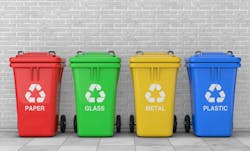Revitalize Your Recycling Program With 3 Key Steps
When COVID-19 became a global pandemic in early 2020, shelter-in-place orders kept many consumers at home. As a result, many retail businesses focused on economic survival and sanitation rather than sustainability, leading to a drop in demand for recycling at commercial facilities and laxer enforcement of mandatory regulations like California’s AB 827, which requires some businesses to place bins for commercial organic waste next to trash bins.
One year later, as consumers adapt to life during a pandemic, sustainability is returning to top-of-mind, including enforcement of regulations promoting eco-friendly waste disposal.
For managers of commercial facilities, now is the perfect time to fine-tune existing waste disposal practices and sustainability. Keeping these three steps in mind will ensure that you create an effective waste disposal program while complying with state and city recycling requirements.
1. Put a Plan in Place for Enclosures
Designing workable waste disposal enclosures is often not first on the list when planning a new building. All too often, building planners and managers focus on the aesthetics of their waste disposal enclosures, but there are also important logistical considerations, like the amount of clearance needed for disposal trucks to access trash compactors and recycling dumpsters.
It is important to stay ahead of the latest recycling regulations and local ordinances and to adequately educate tenants about proper recycling practices. Engaging a waste management consultant early in the design process can help planners head off any potential miscalculations if this is not your area of expertise.
[Related: Why You Need an E-Waste Recycling Program]
2. Account for Illegal Dumping
Illegal dumping is a big problem for managers of commercial facilities. Most of the time, the worst offenders are not the tenants themselves, but members of the public who use dumpsters at nearby retail complexes to get rid of unwanted junk.
In terms of what is dumped, the sky is the limit. Unless you have a waste disposal plan in place to address illegal dumping, absolutely anything and everything from washing machines to the kitchen sink could end up in your dumpsters. In the worst cases, harmful materials like electronics and hazardous wastes can jeopardize tenant and consumer safety or put you out of compliance with waste disposal laws.
While it might not be possible to eliminate illegal dumping altogether, it is possible to address the issue in an eco-friendly way. One option is to work with a junk removal business that finds ways to reuse unwanted items. Ask whether they run their trucks on biodiesel, which will eliminate pollution during the removals.
When looking for a junk removal company, check to see whether they either donate or recycle reusable items instead of sending them to landfill. You also want to make sure your waste disposal vendor has a plan for safely disposing of any harmful materials.
[Related: The Many Benefits of Industrial Recycling Programs]
3. Educate Others to Optimize Your Recycling Plan
With the best of intentions, tenants can contaminate entire loads simply because they don’t understand what can and cannot be recycled. For example, tenants often toss wax-coated cardboard or plastic bags filled with mixed recyclables in the nearest recycling dumpster.
Because wax-coated cardboard can’t be recycled and plastic bags get hung up in sorting machines at distribution centers, many haulers consider recycling loads that contain more than 10% of these items as contaminated and send them straight to landfill, thereby defeating the purpose of recycling programs.
One way to prevent too much plastic from ending up in your recycling is to reuse cardboard boxes as bins for your paper recyclables. When the box is full, you can carry it out to the dumpster and recycle the entire contents, box and all. If you do need to use plastic bags to carry recyclables, empty the contents into the recycling container and then dispose of the plastic bag in a trash dumpster. Better yet, take the plastic bag with you and reuse it for your next load of recycling.
Educating tenants about proper recycling practices and posting signage about what can be recycled (and where) are two more ways to prevent contamination and make sure your recyclables don’t end up in landfill.
With so many responsibilities, building owners and managers may struggle to implement an efficient waste management program. Engaging experts in waste management can alleviate this burden while providing other invaluable services, like performing audits to optimize waste disposal, educating tenants on recycling practices, and implementing technology solutions to monitor tenant practices and recycling compliance.
Whether you are reviving your recycling initiative after the pandemic or designing something new, a well-designed waste management program is a great way to make your job easier and benefit the environment.
About the Author:
Rain Vaught Apperson, Regional Manager for RWS Facility Services, has more than a decade of experience in strategically designing waste, recycling and organics programs to best fit the unique needs of commercial and residential properties.
About the Author

Contributed Author
BUILDINGS partners with industry experts to bring you contributed content covering the hot topics for building owners and facility professionals.
